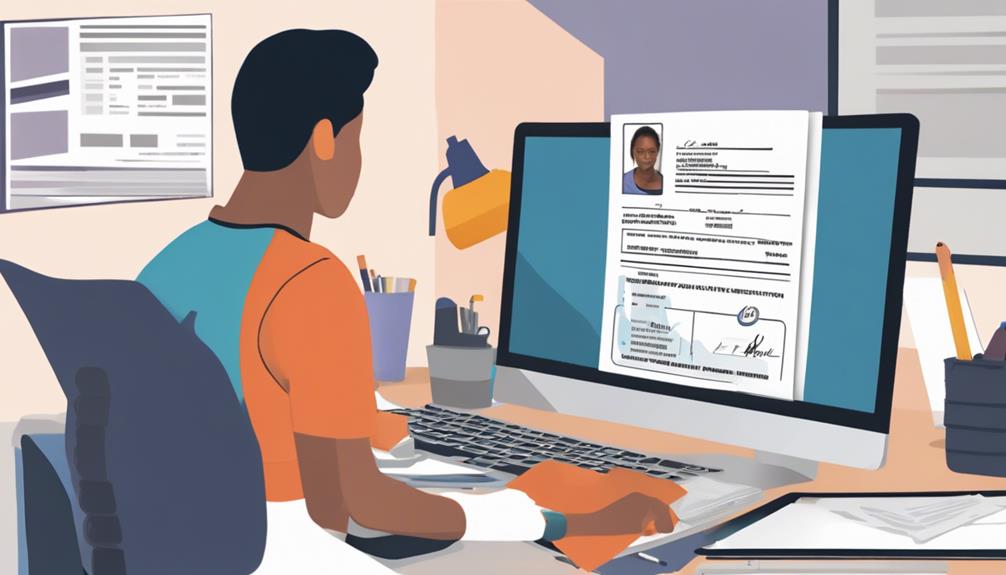What Steps to Take for Athletic Training Certification?
Embarking on the journey to obtain athletic training certification is akin to stepping onto a meticulously planned track, each step paving the way for your professional advancement.
But what lies beyond the initial hurdles of eligibility requirements and program selection is a comprehensive roadmap waiting to be navigated.
As you take each stride towards your goal, the path will unfold with clarity and purpose, guiding you towards a rewarding career in athletic training.
Determine Eligibility Requirements
To become certified in athletic training, you must first determine if you meet the eligibility requirements. Review prerequisites carefully to ensure you have the necessary qualifications. Start by checking if you have completed a bachelor's degree from a program accredited by the Commission on Accreditation of Athletic Training Education (CAATE). This is a fundamental requirement that serves as the foundation for pursuing certification in athletic training.
Next, verify qualifications related to specific coursework. Make sure you have completed courses in areas such as biology, chemistry, physics, anatomy, and physiology. These courses are crucial as they provide the knowledge base essential for understanding the human body and its functions, which is integral to athletic training.
Additionally, gaining practical experience through clinical rotations or internships is often a requirement. Ensure you have fulfilled the necessary hours of hands-on experience working under the supervision of a certified athletic trainer. This practical component is vital for applying theoretical knowledge in real-world scenarios and developing essential skills in injury prevention, assessment, and rehabilitation.
Choose an Accredited Program
Now, as you progress in your journey towards athletic training certification, your next step is selecting an accredited program that aligns with your career goals and educational needs. To begin, research options available to you. Look into universities, colleges, or online programs that offer athletic training certification. Consider factors such as program reputation, faculty expertise, facilities, and resources provided. It's crucial to choose a program that won't only meet the certification requirements but also provide you with a comprehensive education in athletic training.
Once you have identified a few potential programs, take the time to compare them. Look at the curriculum of each program to ensure it covers all the necessary coursework for certification. Consider the program's format – whether it's full-time, part-time, online, or on-campus – and determine which best fits your schedule and learning preferences. Additionally, compare the program costs, including tuition, fees, and any additional expenses. Keep in mind that while cost is a factor, the quality of education should be your top priority.
Complete Required Coursework
You should begin by enrolling in and successfully completing the required coursework for athletic training certification. This coursework will provide you with the foundational knowledge and skills needed to excel in this field. As you progress through your coursework, you'll have the opportunity to gain hands-on practice and develop practical skills that are essential for working as an athletic trainer.
The required coursework for athletic training certification typically covers subjects such as anatomy, physiology, kinesiology, biomechanics, nutrition, and injury prevention. These courses will give you a solid understanding of the human body, how it moves, and how to prevent and treat injuries that may occur during physical activity.
In addition to theoretical knowledge, your coursework may also include practical components where you'll have the chance to apply what you have learned in a real-world setting. This hands-on practice is invaluable for honing your skills and preparing you for the demands of working with athletes in various sports settings.
Gain Clinical Experience
Ready to immerse yourself in real-world scenarios and apply your knowledge? Gaining clinical experience is a crucial step in your journey towards athletic training certification. This hands-on learning opportunity provides you with the practical skills needed to excel in the field.
During your clinical experience, you'll have the chance to work directly with athletes under the supervision of experienced professionals. This immersive environment allows you to apply the theoretical knowledge gained from your coursework in a real-world setting. By working closely with athletes, you'll learn how to assess injuries, provide immediate care, and develop rehabilitation plans tailored to individual needs.
Engaging in clinical experience not only enhances your skills but also helps you build confidence in your abilities. Through practical application, you'll develop a deeper understanding of athletic training principles and best practices. This hands-on learning approach prepares you for the challenges you may face in a fast-paced sports environment.
Furthermore, gaining clinical experience can also open doors to future opportunities in the field. Building a network of connections during your clinical placement can lead to potential job offers or recommendations. By actively participating in clinical settings, you demonstrate your dedication to the profession and your commitment to honing your skills as an athletic trainer.
Obtain CPR/AED Certification
Immersed in the practical skills gained from your clinical experience, the next vital step is obtaining CPR/AED certification to further equip yourself for athletic training certification. This certification is crucial as it ensures you're prepared to handle emergency situations that may arise while working with athletes. Here are some key points to consider:
- Hands-On Practice: CPR/AED certification courses provide hands-on practice, allowing you to develop the necessary skills to perform cardiopulmonary resuscitation (CPR) and operate an automated external defibrillator (AED) effectively. This practical experience is invaluable in emergency situations.
- Emergency Response Training: Through CPR/AED certification, you'll receive training on how to respond promptly and correctly in case of cardiac arrest or other life-threatening incidents. This training will give you the confidence to act decisively when every second counts.
- Essential Skillset: CPR/AED certification adds to your skillset as an athletic trainer, demonstrating your commitment to the safety and well-being of the athletes under your care. It's a requirement for most athletic training certification programs and showcases your readiness to handle medical emergencies competently.
Pass the Board of Certification Exam
Successfully passing the Board of Certification Exam is a crucial milestone on the path to becoming a certified athletic trainer. To ace this exam, you need to implement effective study strategies and thorough exam preparation.
Start by creating a study schedule that allows you to cover all the relevant topics without feeling overwhelmed. Break down the material into manageable sections and allocate specific times for studying each day. Practice tests are invaluable tools for familiarizing yourself with the exam format and assessing your knowledge gaps. Utilize online resources, study guides, textbooks, and flashcards to reinforce your understanding of key concepts.
Engage in group study sessions to benefit from different perspectives and explanations. Teaching others the material can also enhance your own understanding. When studying, prioritize topics that you find challenging while still reviewing the areas where you feel confident.
On the day of the exam, ensure you get a good night's sleep and have a nutritious breakfast to fuel your brain. Arrive early at the testing center, so you have time to relax and mentally prepare. During the exam, read each question carefully, and manage your time wisely to answer all questions.
Apply for State Licensure

Consider submitting your application for state licensure to take the next step in your journey towards becoming a certified athletic trainer. To become a licensed athletic trainer, you need to navigate the licensing process and ensure you have all the required documentation in place. Here are some key points to keep in mind:
- Understanding State Regulations: Familiarize yourself with the specific regulations set by your state regarding athletic training licensure. Each state may have slightly different requirements, so it's crucial to be well-informed.
- Gathering Required Documentation: Prepare all the necessary documentation as part of your application process. This may include transcripts, proof of passing the certification exam, background checks, and more. Make sure you have everything organized and ready to submit.
- Completing the Application Process: Follow the instructions provided by your state licensing board carefully when filling out your application. Pay attention to deadlines and ensure that all sections are completed accurately to avoid any delays in the process.
Maintain Certification Through Continuing Education
To stay current and keep your athletic training certification active, engage in ongoing professional development through continuing education opportunities. Professional development is crucial for maintaining your skills and knowledge in the field of athletic training. Attend workshops, participate in online modules, and join seminars to stay updated on the latest trends and techniques.
Workshops provide hands-on training and networking opportunities with other professionals in the field. These interactive sessions allow you to enhance your practical skills and learn from experienced trainers. Online modules offer flexibility, allowing you to complete coursework at your own pace. These modules cover a wide range of topics, from injury prevention to rehabilitation strategies.
Seminars are a great way to delve deeper into specific areas of athletic training. Experts in the field share their knowledge and insights, keeping you informed about advancements in sports medicine. By actively engaging in these continuing education opportunities, you demonstrate your commitment to professional growth and excellence in athletic training.
Frequently Asked Questions
Can I Become a Certified Athletic Trainer Without a Bachelor's Degree in a Related Field?
Yes, you can become a certified athletic trainer without a bachelor's degree in a related field. Career opportunities may expand with continuing education. Job prospects could increase, and specializations may become more accessible.
It's important to research specific requirements for certification to ensure you meet all necessary criteria. Pursuing additional education in athletic training can enhance your skills and open up new avenues for professional growth.
Are There Any Alternative Pathways to Becoming a Certified Athletic Trainer if I Don't Meet the Traditional Eligibility Requirements?
If you don't meet the traditional eligibility requirements for athletic training certification, there are alternative pathways to consider.
Some certification options may offer non-traditional pathways for those with different educational backgrounds.
Look into these alternative pathways to see if they align with your qualifications and goals.
Research certification options that may have flexible eligibility requirements that could work for you.
How Long Does It Typically Take to Complete the Required Coursework for Athletic Training Certification?
Completing the required coursework for athletic training certification typically takes around 4 years. This duration includes both classroom learning and clinical experience.
You can use study resources like textbooks, online modules, and practice exams to prepare. Once you meet the eligibility requirements, you can take the certification exam.
Are There Specific Types of Clinical Experience That Are More Beneficial for Aspiring Athletic Trainers?
When aspiring athletic trainers seek experience, practical exposure through internships and hands-on training becomes crucial. Clinical settings offer valuable insights into the field, enhancing your skills and knowledge.
Different types of clinical experiences, such as working with sports teams, physical therapy clinics, or rehabilitation centers, can provide diverse perspectives and prepare you for the demands of the profession. Seek opportunities that align with your interests and goals to maximize your growth.
How Often Do I Need to Renew My Cpr/Aed Certification in Order to Maintain My Athletic Training Certification?
To maintain your athletic training certification, you typically need to renew your CPR/AED certification every two years. This ensures you stay current with life-saving skills.
Incorporate hands-on training methods to enhance your knowledge and skills. Be sure to check the specific certification requirements for your program.
Prepare for your exams thoroughly to increase your chances of success. Stay up to date and dedicated to your training to excel in the field.
Conclusion
Now that you have completed the necessary steps for athletic training certification, you're well on your way to a successful career in the field.
By meeting eligibility requirements, choosing an accredited program, completing coursework, gaining clinical experience, obtaining CPR/AED certification, passing the board exam, applying for licensure, and maintaining certification through continuing education, you have set yourself up for success in the competitive world of athletic training.
Keep up the hard work and dedication!
